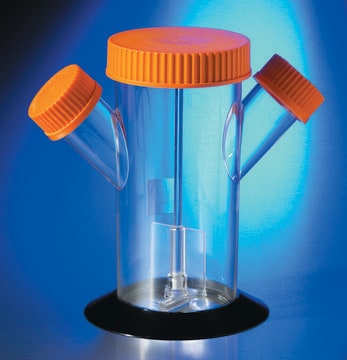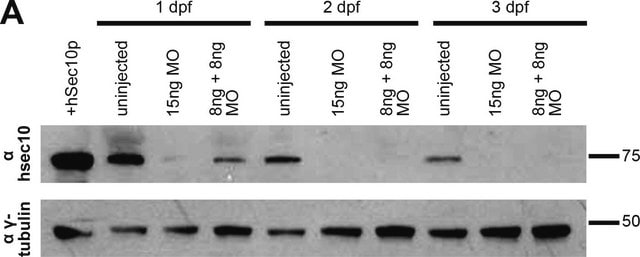일반 설명
Breast cancer resistance protein (BCRP1), also known as placenta-specific ATP-binding cassette (ABC) protein (ABCP) or ABC G-subfamily member 2 (ABCG2), or mitoxantrone resistance protein (MXR), is a member of the ATP-binding cassette superfamily of drug transporters thought to be involved in multi-drug resistance in human neoplastic disease. ABCG2 is expressed in drug-resistant breast, colon and gastric cancer and fibrosarcoma cancer cell lines and in blast cells from patients with acute myeloid leukemia (AML). Normal tissues that express the ABCG2 protein include placental syncytiothrophoblasts, mammary ducts and lobules, epithelium in the large intestine and colon, venous and capillary epithelium and bile canalicular membrane of the liver. Several studies indicate that ABCG2 is also expressed in stem cells of different tissues and may be useful as a stem cell marker. ABCG2 is thought to be responsible for the ability of a population of very primitive hematopoietic and non-hematopoietic cells, the so-called SP (side population) subset, to efflux the Hoechst 33342 fluorescent dye. Semiquantitative RT-PCR results indicate that ABCG2 mRNA is expressed at higher levels in SP cells as compared to non-SP cells in human, rhesus monkey and mouse hematopoietic tissues, with the exception of erythroblasts and NK cells. In human bone marrow, ABCG2 mRNA expression is higher in phenotypically defined populations of primitive CD34+CD38- hematopoietic cells as compared to more differentiated CD34+CD38+ progenitor cells. Bcrp1 mRNA is also expressed in SP cells in murine skeletal muscle, in neural stem cell and progenitor cells and in nestin-positive pancreatic islet derived progenitor cells. Over-expression of the human ABCG2 gene by retroviral-mediated gene transfer confers the SP phenotype to mouse bone marrow cells. Bcrp1 mRNA is expressed in SP as well as non-SP fractions of mouse embryonic stem cells. This suggests that Bcrp1 protein levels may not always be reflected by mRNA levels, or that other characteristics of stem cells, for example, cell cycle status or expression of other transporters, are also involved in the SP phenotype.
특이성
Specifically recognizes an external epitope of the human form of ABCG2. Reportedly reacts with mouse stem cell lines (Ginis, et al., 2004), however mouse reactivity is unsupported at this time.
면역원
3T3 cells expressing human ABCG2
애플리케이션
Detect BCRP1 using this Anti-BCRP1 Antibody, clone 5D3 validated for use in FC, IC, IF, FUNC & WB.
Immunocytochemistry:
Cell cultures fixed with 4% PFA 5-15 minutes at room temperature. Blocking with 10% NGS, 0.1% BSA in PBS with 0.3% Triton X-100 (Ginis et al., 2004).
Flow Cytometry:
1:100-1:1000 dilution from a previous lot was used.
Inhibition Assay:
A previous lot was used to inhibit ABCG2 (Watanabe, K. et al., (2004. FEBS Letters 565:6-10). See also Sarkadi, B., et al., 2004 FEBS 567:116-120,. Sarkadi reports that the detection and inhibition by 5D3 strongly depends on the actual conformation of ABCG2.
Blocking with 10% NGS, 0.1% BSA in PBS with 0.3% triton X-100 (Ginis, 2004).
Optimal working dilutions must be determined by end user.
Research Category
Stem Cell Research
Research Sub Category
Neural Stem Cells
Hematopoietic Stem Cells
품질
Routinely evaluated by Western Blot on L6 lysates.
Western Blot Analysis:
1:500 dilution of this lot detected BCRP1 on 10 μg of L6 lysates.
물리적 형태
Format: Purified
Protein A purified
Purified mouse monoclonal IgG2bκ liquid in buffer containing PBS, pH 7.4, with 0.1% sodium azide.
저장 및 안정성
Stable for 1 year at 2-8ºC from date of receipt. Do not freeze.
기타 정보
Concentration: Please refer to the Certificate of Analysis for the lot-specific concentration.
법적 정보
CHEMICON is a registered trademark of Merck KGaA, Darmstadt, Germany
면책조항
Unless otherwise stated in our catalog or other company documentation accompanying the product(s), our products are intended for research use only and are not to be used for any other purpose, which includes but is not limited to, unauthorized commercial uses, in vitro diagnostic uses, ex vivo or in vivo therapeutic uses or any type of consumption or application to humans or animals.









